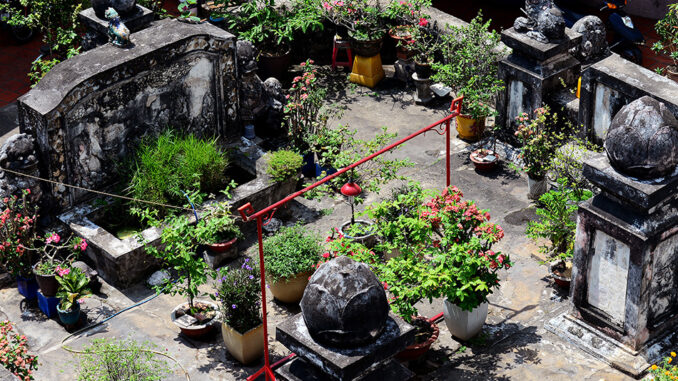
HO CHI MINH CITY – The tomb of marine general Vo Di Nguy was built superficially, bearing the typical architectural features of the South, now more than 200 years old.

The Tomb of Vo Di Nguy (1745 – 1801) is located on a land of nearly 100 m2, in an alley on Co Giang Street (Phu Nhuan district), 220 years old. In front of the grave is the temple of the Martial General. In the temple, there are also two ordinances of King Minh Mang, who reclaimed the title, inscribed on golden silk, in a wooden box with red cloth rolls placed in the shrine. Currently, the temple of Vo Duy Nghi is closed, not receiving visitors to prevent Covid-19.
Vo Di Nguyet was born in Thua Thien (now Thua Thien – Hue province), according to Nguyen Anh (King Gia Long) from the age of 30, was conferred the title of Binh Giang District Public. From there, he became a trusted god, entrusted by God to look after the sailors and the building of ships.
He died in a naval battle with the Tay Son army at Thi Nai gate in 1801. His body was brought back and buried in Gia Dinh. King Gia Long built a superficial tomb. In 1807, Vo Di Nguy was ordained to be the first of all, and was conferred the title of “The murder of the god, special attacker of the upper echelon of Thieu Bao District”

His mausoleum consists of the tomb (front front, shrine) and grave (tomb door, incense table, grave and rear screen). Up to now, the tomb retains its majesty, and at the same time represents the art of building ancient tombs in the South.
The tomb is separated by two walls, leaving the entrance in the middle. The tomb includes the front screen, the lotus-shaped pillars leading to the main tomb.

Tomb area with a screen of about 1.8 m high on both sides with a lion statue. The outside of the screen touches the dragon phoenix, the inside of the screen touches the shape of “coniferous bud” (clouds, pine trees and deer). In the middle of the tomb area, there is a small water tank that describes the life associated with the river of the naval general Vo

Embracing the screen are 2 stone lion statues, meant to protect the resting place of General Vo Duy Nghi. The statue is carved majestic with protruding eyes, spread tail, and bared teeth.

In the tomb, there are also statues of turtles, ducks and lions carved on the walls and pillars. Prominent is the statue of two otters lying on the wall leading to the grave. An otter is an animal that is good at diving, symbolizing Vo Di Nguy’s talent.

The grounds inside the main tomb showcases a variety of ornamental plants. The rectangular grave is built with an umbrella (the compound commonly used in gravestone), protruding about 0.25 m from the grave ground, with a patterned only surrounding road.
Behind the grave is the posterior screen, there are two rectangular boxes, the right box shows the merits of Vo Di Nguy, the left box tells about the status of Mrs. Le Thi Muoi (the wife of Vo General Cong).

The two sides of the rear screen are covered with dragon-shaped reliefs.

Along the wall surrounding the tomb, connected together by many rectangular reliefs, embossed flower vases, pheasants, peacocks, peony, conifers, four spirits, chrysanthemum chrysanthemum …

In addition to the wall of General Vo Di Nguy’s grave, there are four tombs of his wife, son and daughter-in-law.
Before 1985, Ho Chi Minh City had 2 streets named Vo Di Nguy in District 1 and Phu Nhuan district. The tomb was recognized by the Ministry of Culture, Sports and Tourism as a National Architectural Monument in 1993. Follow vnexpress
